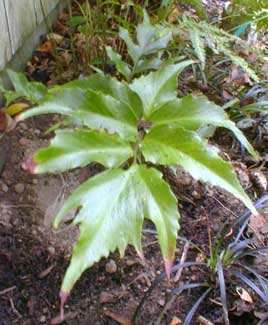
Japanese Giant
Netvein Holly Fern
"And we will build a cottage there
Beside an open glade,
With black-ribbed blue-bells blowing near,
And ferns that never fade."
-Claude McKay
(1889-1948)
(1889-1948)
Native to a large part of the planet including South Africa, India, Japan, & Polynesia, Cyrtomium falcatum is the largest of our three holly ferns. We also have C. fortunei of intermediate size, & C. caryotideum which is a dwarf. C. falcatum can grow two to three feet tall, & slowly spread to just about the same width.
Holly ferns are named for their tough fronds reminiscent of sharp holly leaves. In Japan it is called Oni Yabusotetsu, the Devil's Fern, as it has an almost threatening demeanor, having such large toothy leaves.
It has been popular as a house plant or garden plant since the Victorian era, & has escaped from cultivation in many places around the world, including in California, the southwest states, & the deep south. Here in the Pacific Northwest it is not at all aggressive, but can sometimes be a tad delicate.
In a protected location, the erect fronds are strongly evergreen through our mild Zone 8 winters. Its ideal, however, would be Zone 9 or 10. It will be a die-back perennial in zones 6 or 7, & often will not return in spring at all.
It's the least cold-hardy of our three holly ferns so I put it in a very protected shady location. The shade corridor is moist along one edge, but somewhat dry on the side closest to the house since we don't let it get too wet along the basement's wall. For its first year this holly fern was on the dryish side of the shade corridor, & during a record-droughty summer it lost its tough leaves one by one.
If life gets totally droughty for one of these holly ferns, they go dormant so as to not be killed; the leaves might or might not still look perfectly all right, but the fern will not start growing again until soil is moist. By summer's end this one had only a couple nice leaves. I finally moved to the moist side of the corridor where it's doing much better & bouncing back to vitality.
The photo above shows it in October in its new location. It will inevitably take its bloody sweet time getting bushed out anew, but it's impressive that it survived the initially harsh location, & now that it has a more ideal location I'm sure it'll be a good-looking fern next year.
Although soil should be moderately moist, it does dislike overwatering, & will rot into nothing in soggy soil. It is not otherwise fussy about soil conditions, doing well in acidic, neutral, or slightly alkaline soils. It also makes a good container plant, & can even survive indoors without griping about low humidity the way so many ferns do. Many ferns dislike fertilizer, but a little dilute fertilizer each spring pleases this holly fern.
Extended sun exposure can ruin it, though it doesn't mind a bit of direct sunlight at some point during the day. Though it can be strongly evergreen in shade & away from winter winds, it will get very beaten up in winter in a more exposed area.
Cruddy-looking leaves can be trimmed away in early spring, careful not to damage the crown, & fresh fronds will soon appear. If it kept through the winter prettily & the old fronds still look nice, there's no hurry about trimming them.